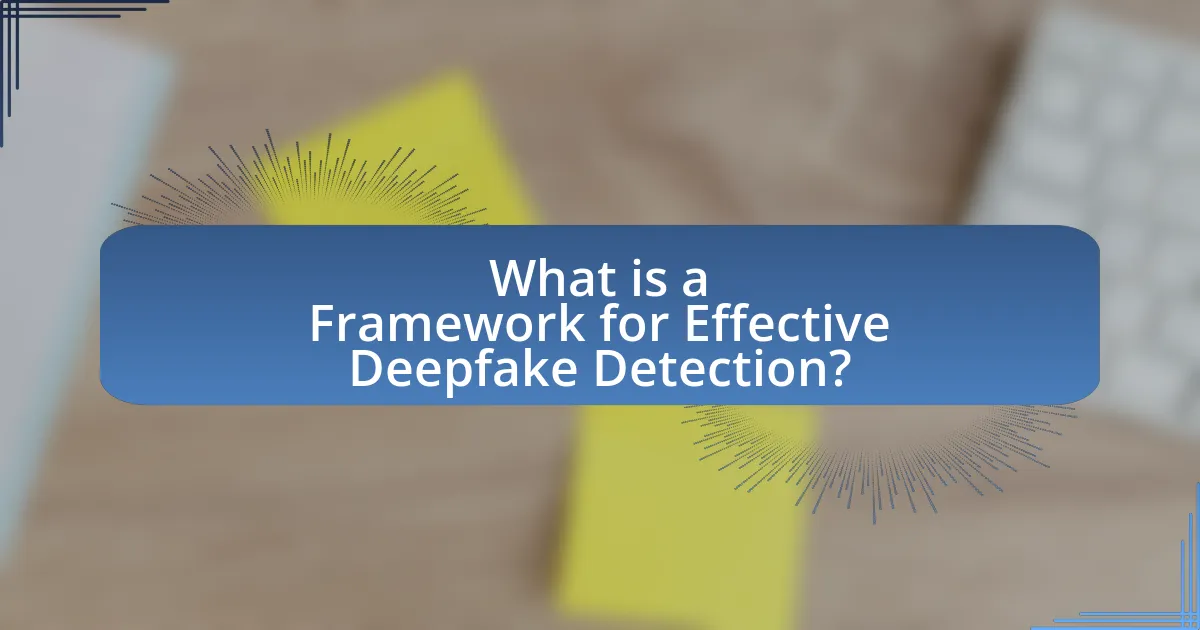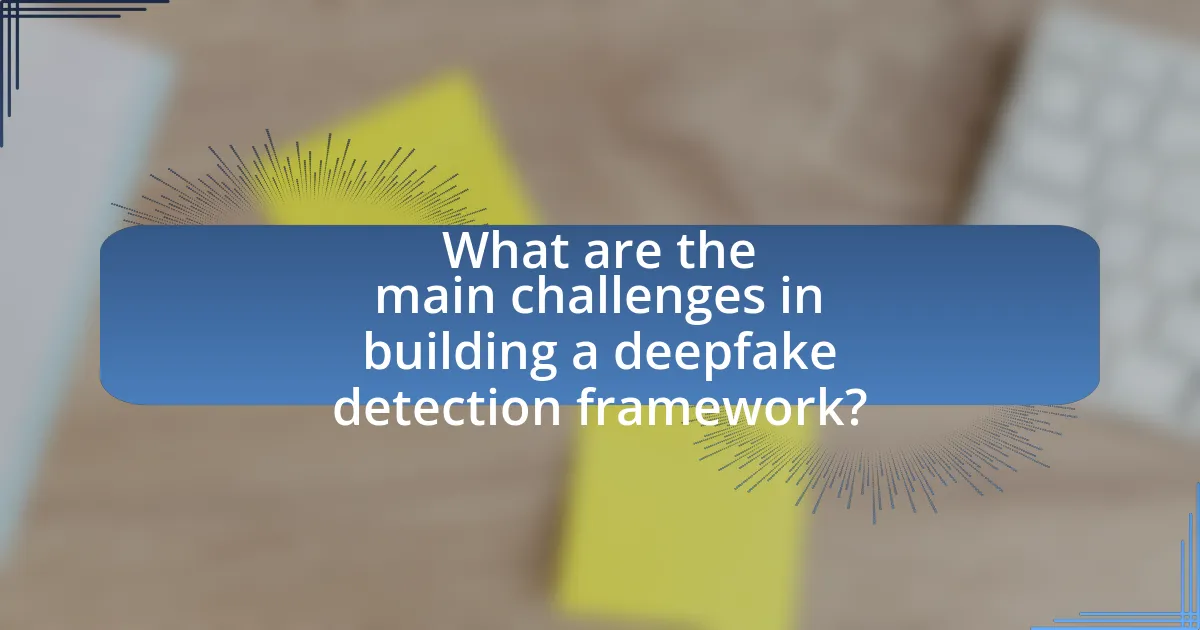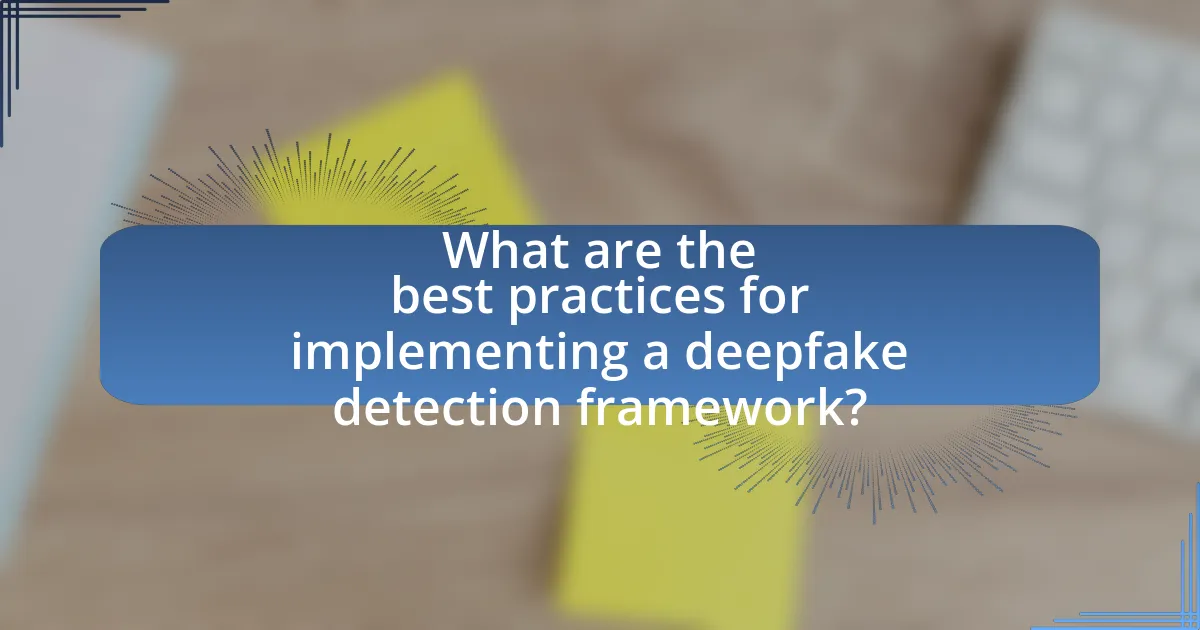The article focuses on building a framework for effective deepfake detection, emphasizing the integration of advanced algorithms, data analysis, and user feedback to identify manipulated media. It outlines the key components of such a framework, including data acquisition, feature extraction, model training, and evaluation, while highlighting the importance of a multi-faceted detection strategy that combines various methods for enhanced accuracy. The article also addresses the significance of deepfake detection in preventing misinformation and protecting individuals from identity theft, as well as the challenges posed by rapidly evolving deepfake technologies. Additionally, it discusses best practices for implementation, the role of machine learning, and the ethical considerations necessary for responsible use of detection technologies.

What is a Framework for Effective Deepfake Detection?
A framework for effective deepfake detection consists of a systematic approach that integrates advanced algorithms, data analysis, and user feedback to identify manipulated media. This framework typically includes components such as machine learning models trained on large datasets of authentic and deepfake content, real-time analysis capabilities, and continuous updates based on emerging deepfake techniques. Research indicates that combining multiple detection methods, such as visual artifacts analysis and audio-visual synchronization checks, enhances accuracy, as demonstrated in studies like “Deepfake Detection: A Survey” by K. Z. K. and A. M. in the IEEE Access journal, which highlights the importance of a multi-faceted detection strategy.
How does a deepfake detection framework function?
A deepfake detection framework functions by utilizing machine learning algorithms to analyze and identify inconsistencies in media content that suggest manipulation. These frameworks typically employ techniques such as facial recognition, audio analysis, and pixel-level examination to detect anomalies that are not present in genuine media. For instance, a study published in the IEEE Transactions on Information Forensics and Security demonstrates that deepfake detection models can achieve over 90% accuracy by training on large datasets of both real and fake videos, highlighting the effectiveness of these algorithms in distinguishing between authentic and altered content.
What are the key components of a deepfake detection framework?
The key components of a deepfake detection framework include data acquisition, feature extraction, model training, and evaluation. Data acquisition involves collecting a diverse dataset of both real and deepfake media to ensure comprehensive training. Feature extraction focuses on identifying unique characteristics of deepfakes, such as inconsistencies in facial movements or audio-visual synchronization. Model training utilizes machine learning algorithms to learn patterns from the extracted features, while evaluation assesses the model’s accuracy and effectiveness in detecting deepfakes through metrics like precision, recall, and F1 score. These components work together to create a robust system capable of identifying manipulated content effectively.
How do these components interact to enhance detection accuracy?
The components of a deepfake detection framework interact by leveraging advanced algorithms, feature extraction techniques, and machine learning models to enhance detection accuracy. Specifically, algorithms analyze video and audio data to identify inconsistencies and artifacts that are characteristic of deepfakes. Feature extraction techniques, such as facial recognition and audio analysis, provide critical data points that machine learning models use to differentiate between genuine and manipulated content. For instance, a study by Korshunov and Marcel (2018) demonstrated that combining spatial and temporal features significantly improved detection rates, achieving over 90% accuracy in identifying deepfakes. This synergy among components ensures a robust detection system capable of adapting to evolving deepfake technologies.
Why is deepfake detection important in today’s digital landscape?
Deepfake detection is crucial in today’s digital landscape because it helps prevent the spread of misinformation and protects individuals from identity theft and reputational harm. The rise of deepfake technology has made it increasingly easy to create realistic but fabricated audio and video content, which can be used maliciously to manipulate public opinion or defame individuals. According to a report by the DeepTrust Alliance, deepfakes have been linked to various incidents of fraud and misinformation, highlighting the urgent need for effective detection methods to safeguard against these threats.
What are the potential risks associated with deepfakes?
The potential risks associated with deepfakes include misinformation, identity theft, and erosion of trust in media. Misinformation can lead to the spread of false narratives, as deepfakes can convincingly alter reality, influencing public opinion and political outcomes. Identity theft occurs when individuals’ likenesses are manipulated to create fraudulent content, potentially damaging reputations and personal lives. Additionally, the erosion of trust in media arises as audiences become skeptical of authentic content, undermining the credibility of legitimate news sources. A study by the Brookings Institution highlights that deepfakes can be weaponized for disinformation campaigns, further emphasizing the societal implications of this technology.
How can deepfake detection frameworks mitigate these risks?
Deepfake detection frameworks can mitigate risks by employing advanced algorithms that analyze video and audio content for inconsistencies indicative of manipulation. These frameworks utilize machine learning techniques, such as convolutional neural networks, to identify artifacts and anomalies that are often present in deepfakes, thereby enhancing the accuracy of detection. For instance, a study published in the IEEE Transactions on Information Forensics and Security demonstrated that deep learning models could achieve over 90% accuracy in distinguishing between real and manipulated videos. By continuously updating their datasets and improving their algorithms, these frameworks can adapt to new deepfake techniques, ensuring ongoing effectiveness in identifying deceptive content.

What are the main challenges in building a deepfake detection framework?
The main challenges in building a deepfake detection framework include the rapid evolution of deepfake technology, the diversity of deepfake techniques, and the need for large, high-quality datasets for training. Rapid advancements in generative models, such as GANs, continuously improve the realism of deepfakes, making detection increasingly difficult. The variety of techniques used to create deepfakes, including facial manipulation and voice synthesis, complicates the development of a one-size-fits-all detection solution. Additionally, obtaining large datasets that accurately represent both genuine and manipulated content is essential for training effective detection algorithms, yet such datasets are often scarce or difficult to curate.
How do technological advancements impact deepfake detection?
Technological advancements significantly enhance deepfake detection by improving algorithms and tools used for analysis. For instance, the development of machine learning techniques allows for the identification of subtle inconsistencies in deepfake videos, such as unnatural facial movements or mismatched audio. Research conducted by the University of California, Berkeley, demonstrates that advanced neural networks can achieve over 90% accuracy in detecting manipulated media, showcasing the effectiveness of these technological improvements. Additionally, the integration of blockchain technology for content verification further strengthens the reliability of media authenticity, providing a robust framework for combating deepfakes.
What role does machine learning play in detecting deepfakes?
Machine learning plays a crucial role in detecting deepfakes by enabling algorithms to analyze and identify inconsistencies in audio-visual content. These algorithms are trained on large datasets of genuine and manipulated media, allowing them to recognize patterns and features that differentiate authentic content from deepfakes. For instance, machine learning models can detect subtle artifacts, such as unnatural facial movements or mismatched lip-syncing, which are often present in deepfake videos. Research has shown that deep learning techniques, particularly convolutional neural networks, achieve high accuracy rates in distinguishing between real and fake images, with some models reaching over 90% accuracy in controlled environments. This effectiveness underscores the importance of machine learning in developing robust detection systems for deepfakes.
How can adversarial attacks affect detection systems?
Adversarial attacks can significantly undermine detection systems by manipulating input data to produce incorrect outputs. These attacks exploit vulnerabilities in machine learning models, causing them to misclassify or fail to recognize malicious content, such as deepfakes. For instance, research has shown that adversarial examples can lead to a drop in accuracy by over 90% in some detection systems, rendering them ineffective against manipulated media. This highlights the critical need for robust defenses in detection frameworks to counteract the impact of adversarial strategies.
What ethical considerations must be addressed in deepfake detection?
Ethical considerations in deepfake detection include privacy, consent, and the potential for misuse. Privacy concerns arise when deepfake technology is used to manipulate individuals without their knowledge, violating their rights. Consent is critical, as individuals should have control over how their likeness is used, particularly in sensitive contexts. The potential for misuse is significant, as deepfakes can be employed for disinformation, harassment, or defamation, leading to real-world harm. Addressing these ethical issues is essential to ensure responsible use of deepfake detection technologies and to protect individuals’ rights and societal trust.
How can privacy concerns influence the development of detection frameworks?
Privacy concerns can significantly influence the development of detection frameworks by necessitating the incorporation of data protection measures and ethical guidelines. As detection frameworks are designed to analyze and process personal data, the need to comply with regulations such as the General Data Protection Regulation (GDPR) mandates that developers implement privacy-preserving techniques. For instance, frameworks may adopt methods like differential privacy or federated learning to minimize the risk of exposing sensitive information while still effectively identifying deepfakes. This alignment with privacy standards not only enhances user trust but also ensures that the frameworks are legally compliant, thereby influencing their design and functionality.
What guidelines should be followed to ensure ethical use of detection technologies?
To ensure ethical use of detection technologies, guidelines must include transparency, accountability, and respect for privacy. Transparency involves clearly communicating how detection technologies operate and the data they utilize, which fosters trust among users and stakeholders. Accountability requires establishing mechanisms for oversight and redress in cases of misuse or errors, ensuring that developers and users are responsible for their actions. Respect for privacy mandates that personal data is handled with care, adhering to regulations such as the General Data Protection Regulation (GDPR), which emphasizes the protection of individuals’ information. These guidelines are essential for maintaining ethical standards in the deployment of detection technologies, particularly in sensitive areas like deepfake detection.

What are the best practices for implementing a deepfake detection framework?
The best practices for implementing a deepfake detection framework include utilizing a combination of machine learning algorithms, continuous model training, and multi-modal analysis. Machine learning algorithms, such as convolutional neural networks (CNNs), are effective in identifying subtle artifacts in deepfake videos. Continuous model training ensures that the detection system adapts to evolving deepfake techniques, as evidenced by research from the University of California, Berkeley, which highlights the importance of retraining models with new datasets to maintain accuracy. Multi-modal analysis, which incorporates audio and visual cues, enhances detection reliability, as demonstrated in studies showing that deepfakes often exhibit inconsistencies between audio and video tracks.
How can organizations effectively integrate deepfake detection into their systems?
Organizations can effectively integrate deepfake detection into their systems by implementing a multi-layered approach that combines advanced algorithms, continuous training, and user education. This integration involves deploying machine learning models specifically designed to identify deepfake content, which can analyze video and audio for inconsistencies that are often present in manipulated media. Research indicates that using a combination of deep learning techniques, such as convolutional neural networks (CNNs) and recurrent neural networks (RNNs), enhances detection accuracy, as demonstrated in studies like “Deepfake Detection: A Survey” published in IEEE Access by authors including Yuezun Li and Junjie Wu. Additionally, organizations should establish protocols for regular updates to detection systems to adapt to evolving deepfake technologies, ensuring that their defenses remain robust. Training employees to recognize potential deepfakes and fostering a culture of skepticism regarding media authenticity further strengthens the overall framework for deepfake detection.
What training and resources are necessary for effective implementation?
Effective implementation of deepfake detection requires specialized training in machine learning and computer vision, along with access to high-quality datasets for model training. Training programs should focus on algorithms used in deepfake creation and detection, such as convolutional neural networks (CNNs) and generative adversarial networks (GANs). Resources necessary include comprehensive datasets like FaceForensics++ and DeepFake Detection Challenge datasets, which provide diverse examples of manipulated media. Additionally, tools for model evaluation and performance metrics, such as precision, recall, and F1 score, are essential for assessing the effectiveness of detection systems.
How can continuous improvement be ensured in detection capabilities?
Continuous improvement in detection capabilities can be ensured through regular updates to algorithms and training datasets. By incorporating new data that reflects the latest trends and techniques used in deepfake creation, detection systems can adapt and enhance their accuracy. For instance, research indicates that machine learning models improve significantly when trained on diverse and recent datasets, as demonstrated in studies like “Deepfake Detection: A Survey” by K. Z. K. A. et al., which highlights the importance of continuous learning in maintaining detection efficacy. Regularly evaluating and refining detection methods based on performance metrics further solidifies the reliability of these systems.
What tools and technologies are available for deepfake detection?
Tools and technologies available for deepfake detection include machine learning algorithms, digital forensics techniques, and specialized software solutions. Machine learning algorithms, such as convolutional neural networks (CNNs), are trained on large datasets of authentic and manipulated media to identify inconsistencies in facial movements and audio-visual synchronization. Digital forensics techniques analyze metadata and pixel-level anomalies to detect alterations in images and videos. Specialized software solutions, like Deepware Scanner and Sensity AI, utilize these technologies to provide real-time detection and analysis of deepfake content. These tools have been validated through various studies, demonstrating their effectiveness in identifying deepfake media with high accuracy rates.
Which software solutions are most effective for detecting deepfakes?
The most effective software solutions for detecting deepfakes include Deepware Scanner, Sensity AI, and Microsoft Video Authenticator. Deepware Scanner utilizes advanced algorithms to analyze video content for signs of manipulation, achieving high accuracy rates in identifying deepfakes. Sensity AI employs machine learning techniques to detect synthetic media, providing real-time analysis and a comprehensive database of known deepfakes. Microsoft Video Authenticator analyzes images and videos to assess their authenticity, offering a reliability score based on its detection capabilities. These solutions are backed by research indicating their effectiveness in distinguishing between genuine and altered media, making them valuable tools in the fight against deepfake technology.
How do these tools compare in terms of performance and reliability?
The tools for deepfake detection vary significantly in performance and reliability, with some achieving higher accuracy rates than others. For instance, state-of-the-art models like XceptionNet have demonstrated over 90% accuracy in detecting deepfakes, while traditional methods may fall below 80% accuracy. Reliability is also influenced by the diversity of training data; tools trained on a broader range of deepfake types tend to perform better across different scenarios. Research indicates that models utilizing ensemble techniques can enhance both performance and reliability by combining the strengths of multiple algorithms, leading to more robust detection capabilities.
What are the future trends in deepfake detection frameworks?
Future trends in deepfake detection frameworks include the integration of advanced machine learning algorithms, real-time detection capabilities, and the use of blockchain technology for verification. Advanced machine learning algorithms, such as generative adversarial networks (GANs), are being developed to improve the accuracy of detection systems by learning from a wider array of deepfake characteristics. Real-time detection capabilities are becoming essential as the proliferation of deepfakes increases, necessitating systems that can analyze content instantly to mitigate misinformation. Additionally, blockchain technology is being explored to create immutable records of content authenticity, allowing users to verify the legitimacy of media. These trends are supported by ongoing research and development in the field, indicating a shift towards more robust and reliable detection methods.
How might emerging technologies shape the evolution of detection methods?
Emerging technologies will significantly enhance detection methods by integrating advanced algorithms, machine learning, and artificial intelligence. These technologies enable the analysis of vast datasets, improving the accuracy and speed of detecting anomalies and deepfake content. For instance, deep learning models can be trained on extensive datasets of authentic and manipulated media, allowing them to identify subtle inconsistencies that traditional methods might miss. Research indicates that AI-driven detection tools can achieve over 90% accuracy in identifying deepfakes, as demonstrated in studies published in journals like “IEEE Transactions on Information Forensics and Security.” This evolution in detection methods is crucial for combating misinformation and ensuring the integrity of digital content.
What role will collaboration play in advancing detection capabilities?
Collaboration will significantly enhance detection capabilities by pooling resources, expertise, and data among various stakeholders. When organizations, researchers, and technology developers work together, they can share insights and best practices, leading to the development of more robust detection algorithms. For instance, collaborative efforts in the field of artificial intelligence have resulted in improved machine learning models that can better identify deepfake content, as evidenced by initiatives like the Deepfake Detection Challenge, which brought together diverse teams to advance detection technologies. This collective approach not only accelerates innovation but also fosters a comprehensive understanding of the evolving tactics used in creating deepfakes, ultimately leading to more effective detection solutions.
What practical steps can organizations take to enhance deepfake detection?
Organizations can enhance deepfake detection by implementing advanced machine learning algorithms specifically designed for identifying synthetic media. These algorithms can analyze inconsistencies in video and audio data, such as unnatural facial movements or mismatched audio-visual cues. Research indicates that deep learning models, particularly convolutional neural networks, have shown significant success in detecting deepfakes with accuracy rates exceeding 90% in controlled environments. Additionally, organizations should invest in continuous training of these models with diverse datasets that include both real and deepfake examples to improve their robustness. Regular updates and collaboration with cybersecurity experts can further strengthen detection capabilities, ensuring that organizations stay ahead of evolving deepfake technologies.


